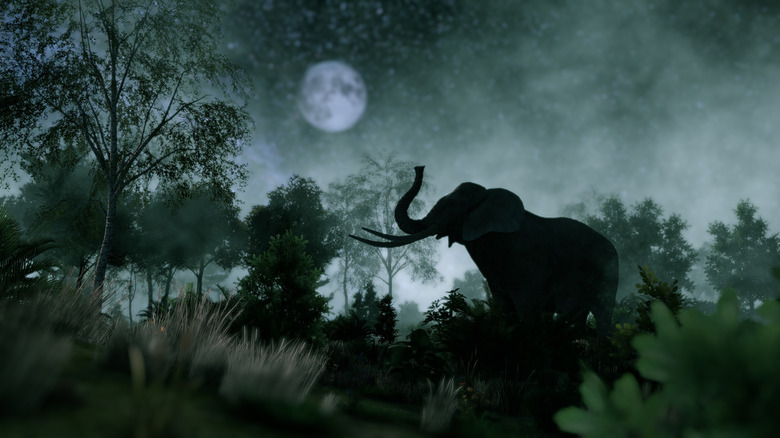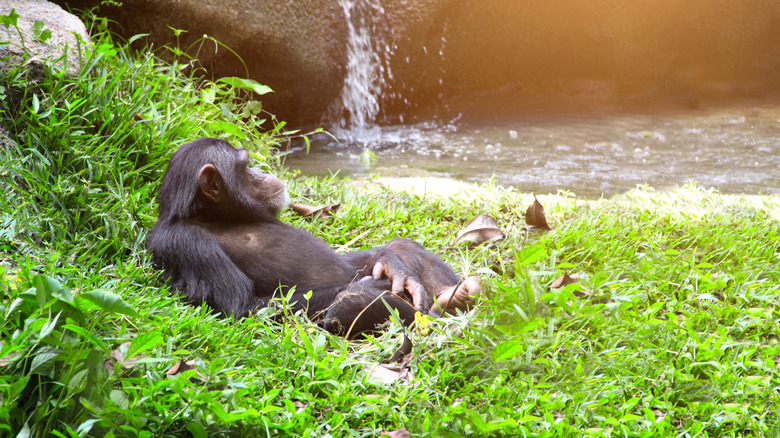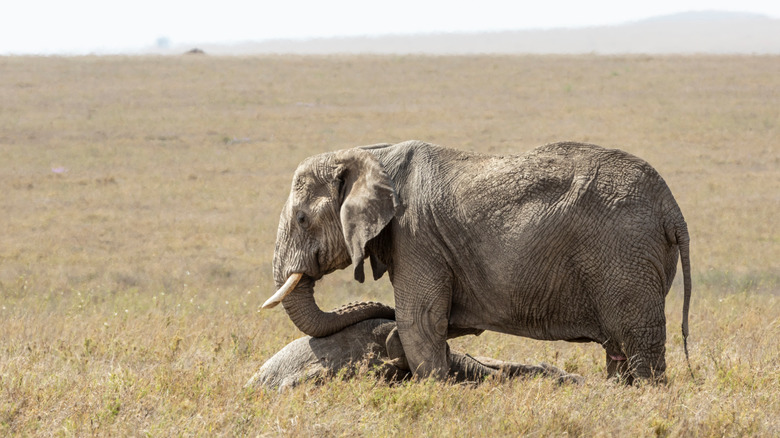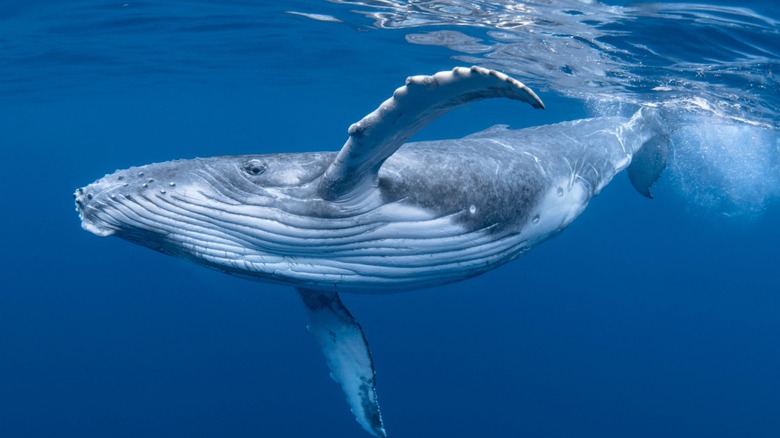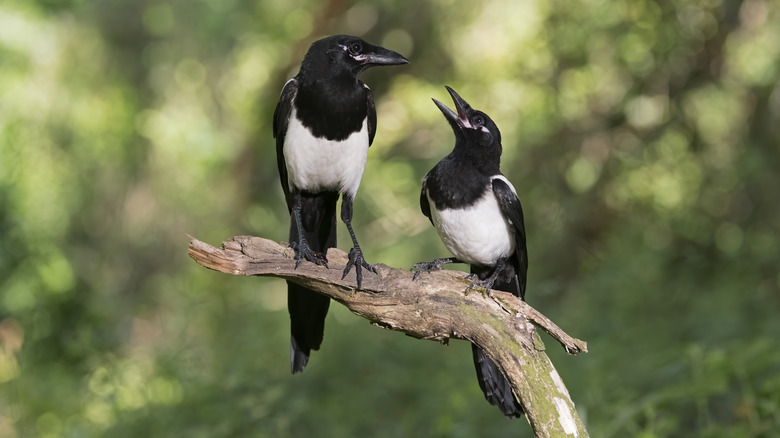Animal Behaviors That Seem Strangely Religious
It's difficult to think at this point that anyone would underestimate the intelligence and emotional depth of Earth's other non-human species. It's also comforting to think of humanity — stranded on a spinning rock in an apparently uncaring cosmos — as uniquely special, purpose-driven, and endowed with an ineffable soul that other creatures lack. At the same time, we live in an era where people seem obsessed with reducing humanity to biological, evolutionarily-driven imperatives that remove the sacred and spiritual from everyday life. With such a bizarre, contradictory stance occupying the spirit of the age, so to speak, it's comforting to think that other earthly creatures might have their own sense of the divine.
At least, that's what it looks like from the outside. Various animals, usually more intelligent mammals like elephants, chimpanzees, whales, etc., seem to demonstrate behavior associated with a spiritual connection with the natural world, if not an unseen, supernatural world. Does that mean that chimps garb themselves in robes and intone magic words while lifting holy, metallurgically-made cups to the sky? Obviously not. But seeing religion for what it really is — the enactment of a prescribed set of ritualistic, repetitive behavior meant to evoke meaning beyond the visibly mundane — means that something like the "prelinguistic dance" of chimps at waterfalls looks like a chimp's version of a religious act, as The Atlantic concurs. At the absolute least, such behavior can shed light on why we, as people, developed our own ritualistic, religious behavior.
Chimpanzee love for falling water
It makes sense that chimpanzees top the list of animals seem to exhibit religious-like behavior. A desire to see meaningful behavior in our closest primate relatives reflects a desire to see the same in ourselves. But since we can't ask chimps to articulate their thoughts we've got to rely on behavior that we witness, like the other animals on this list. Belief isn't measurable.
In fact, chimps have gotten a lot of attention for ritualistic behavior, especially related to falling water — either waterfalls or rain. Jane Goodall, the renowned naturalist who practically wrote the book on chimp society and behavior for decades, has said of chimp dances near waterfalls, "I can't help feeling that this waterfall display, or dance, is perhaps triggered by feelings of awe, wonder [like] we feel," as she says (via Vimeo). And without a doubt, "awe and wonder" are the chief internal experiences of anyone engaged in a religious or spiritual act. The idea is that such water dances set chimps along the path to the kind of "animistic proto-religion" evident in the cave art of our human ancestors.
On that note, however, some have accused Goodall of anthropomorphizing: placing onto non-human creatures human attributes. But like the other animals in this list, it would be more accurate to think of chimps as exhibit chimp religion, elephants elephant religion, whales whale religion, and so forth — not religion of the human variety. Or as The Guardian says, maybe chimps just have the same urge to dance as people.
Elephants wave branches at the moon
Elephants have been long-regarded as creatures of profound depth, especially when it comes to their death rites. They circle up around their dead, touch them, raise their trunks, cover the dead with branches, and in some Asian elephants, even carry calves to small depressions in the ground to more or less bury them. African elephants intentionally visit old death sites, while some Asian elephants go out of their way to avoid them. Death rites can be practical acts, however, and not inherently religious. Other elephant behavior, however, does come across as directly "religious," and casts elephant death rites in a similar light.
Case in point: a very old account from 2 C.E. about elephants lifting branches at the moon and waving them around, cited in a 1977 study in the Journal of Drug Issues. The Roman natural historian Pliny the Elder circa 100 C.E. or so – in book 8 of 37 of observations of the natural world, per Attalus — also wrote that elephants go to rivers to "perform a ritual of purification, sprinkling themselves with water, and after thus paying their respects to the moon." Of course there's a bit of fanciful anthropomorphism tossed in both accounts for literary effect, but that doesn't discredit the actual facts being described. Elephants do indeed engage in very particular behavior that tend to evoke in people the same type of awe that the divine is supposed to evoke in us.
The webs of whale culture
At this point, the reader might start to notice a trend with the animals on this list: Those animals believed to exhibit ritualistic, religion-like behavior have often themselves been imbued by humanity with spiritual significance. In few cases is this as true as with whales, who as Atmos says have often been depicted and revered as "gods that swim among us." Of course, whales are a bit more removed from human society and are much different physically than us. That makes it harder to interpret their behavior. But as two whale experts discuss told The Guardian, whales indeed may display proto-religious behavior.
Whale religiosity emerges from the complexity and nuance of their social structures and attendant morality. Those social structures — even what Biologist Hall Whitehead defines as "culture" — revolve around whale communication methods and nuances in sonar that they use to communicate with each other long distances. Clicks, whistles, songs, specific sounds used for a single whale to identify itself, patterns of sounds passed down generationally through specific kinship groups, songs used to collaborate and organize hunts, songs used to play, and songs that sometimes last up to 20 minutes long: There's no one specific religious behavior on display, rather it's the immensely complex web of interactions that's enough for some to merit the word "religion" when describing whale society and lives. What's more, whales also exhibit death rites like other socially interdependent animals, and scientists have even seen altruism in humpback whales.
Magpies lay wreaths
Corvid intelligence — that's birds like crows, ravens, and magpies — has been well-documented. We know all about how crows use sticks as tools, displace water with rocks in experiments to make food rise to the surface, toss bits of food on the surface of water and then snag fish that come to eat it, and most famously, toss nuts on the street so cars can run over them and crack them open. And then, there's the famous anecdote of crows reasoning as well as a 7-year-old human. And yes, these birds — like other animals on this list — have been long-imbued with spiritual meaning across the globe.
But it's magpies who might exhibit the closest to what we'd call "religious" behavior. Magpies circle up around their dead like elephants, similar to humans around a casket at a funeral. But, it's the "wreaths" — as they've been called — that demonstrate behavior we might define as not merely indicative of mourning, but ritualistic religiosity. Sites like The Telegraph describe magpies fetching sticks to lay around a corpse like a wreath, or humans placing flowers at a grave. Such behavior illustrates a key facet of religious behavior: It's social in nature and primarily serves to strengthen tribal bonds. In other words, there's no obvious practical purpose in placing sticks at a corpse, just like there's no practical purpose in dancing at a waterfall. That's why it appears so odd, and possibly spiritual in nature.
Pigeons can be superstitious
While there are other examples we could end on, it pays to finish with an example that sheds further light on what "religion" actually means, particularly when it comes to belief and hope in unseen forces. To that we turn to an unlikely source: the humble, ubiquitous pigeon. And, we turn to couple scientific experiment that more or less provoked behavior in pigeons that could be interpreted as religious — at least to the human eye.
A paper published in 1948 (via Hanover College Psychology Department) describes an experiment whereby a pigeon received food every 15 seconds regardless of their behavior. But, because the pigeon didn't know what caused the distribution of food, and apparently assumed that it received food based on its own behavior, the pigeon started engaging in seemingly random sets of physical motions in order to produce the food. This included hopping from foot to foot. In other words, and as Nautilus further explains: The pigeon exhibited superstitious behavior, i.e., a type of ritualism meant to illicit a change in the natural world — an admittedly far less flattering way to describe religion than communing with the divine, but one which still fits the definition of religion, even ritual magic. It stands to reason that plenty of other animals might wind up doing the same in similar circumstances.
The same study, it should be noted, also pointed to a connection between apparently displays of religiosity and drug use. Pigeons given hallucinogenic drugs displayed a posture indicating, "surrender, wonder, and awe before a supreme being," according to the 1977 paper, Religious Behavior in Animals and Man: Drug-Induced Effects published in the Journal of Drug Issues.
